
Feel like your head's in a vice? Stress may be to blame for the throbbing pain in your temples. Indeed, a global pandemic coupled with everyday strain from work, family and finances can create the perfect storm for stress headaches.
That's because psychological stress can cause physical tension in our muscles (think: stiff necks and knotted backs). And if these muscles become too tight, they may generate head pain.
Video of the Day
Video of the Day
In fact, tension headaches — aptly named for the role emotional stress plays in prompting them — are the most common type of headache, according to the National Institute of Neurological Disorders and Stroke.
Here's what happens: When you're stressed, muscle groups in your neck, face, scalp, jaw, shoulders and chest tend to contract more than they normally would at rest, Sam Becourtney, PT, DPT, CSCS, physical therapist at Bespoke Treatments, tells LIVESTRONG.com. And these muscle contractions, which "pull" on your head and neck, can cause pain and the sensation of a tight band squeezing your noggin.
In addition to stress, prolonged sitting with poor posture (even more problematic lately thanks to our makeshift home office setups), insufficient sleep and unhealthy eating habits (like skipping meals) can trigger tension headaches, Becourtney says.
Try This 5-Minute Tension-Reducing Stretch Routine
"Stretching can help to relieve the stress and tension by targeting the muscles that tend to be 'overworked'," Becourtney says. Through simple stretching, tight muscles can experience a temporary increase in range of motion, improvement in blood flow and subsequent decrease in stiffness, he explains.
While stretching isn't a magical cure for chronic headaches or migraines — which may be hereditary or caused by other underlying medical conditions — it can, in combination with other treatments, help to ease symptoms.
The next time you feel the painful pressure of a pounding headache, try this five-minute tension-reducing stretch routine designed by Becourtney.
Tip
The National Institute of Neurological Disorders and Stroke also recommends stress-reducing therapies such as biofeedback, relaxation training, meditation and cognitive-behavioral therapy to help you manage stress, often the root cause of tension headaches.
Move 1: Chin Tuck
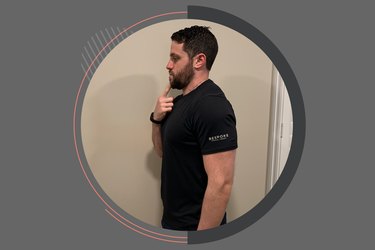
- Use one finger to gently push your chin backwards without flexing or bending the neck down.
- Hold this position for three to five seconds and repeat five to 10 times.
Tip
“The goal of this movement is to create a ‘double chin,’ which helps engage the deep neck flexors and improve head posture, especially when looking at a computer screen for prolonged periods,” Becourtney says.
Move 2: Towel Assisted Neck Extensions
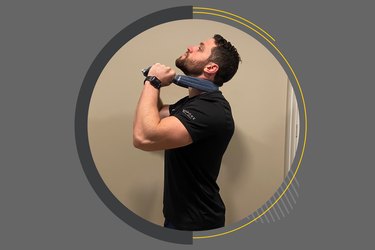
- Place a small towel underneath the base of the skull, holding onto each side with one hand.
- Gently pull on the towel with equal strength on both sides so the towel is applying a directly forward force.
- While maintaining this position, slowly extend your neck by looking up toward the sky, and hold the end position for three to five seconds.
- Return to the starting position, then repeat five to 10 times.
Move 3: Upper Trap Stretch

- Place one hand behind your back. With the opposite hand, reach up and over, grabbing your ear on the opposite side
- Gently pull your ear toward your shoulder without rotating your neck.
- Hold for 20 to 30 seconds and repeat two to three times before switching to the opposite side.
Move 4: Levator Scapulae Stretch
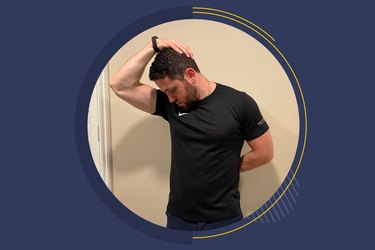
- Place one hand behind your back. With the opposite hand, reach up and over, grabbing your ear on the opposite side.
- Gently pull your nose towards your armpit until you feel a stretch in the neck on the opposite side.
- Hold for 20 to 30 seconds and repeat two to three times before switching to the opposite side.
Move 5: Pec Doorway Stretch
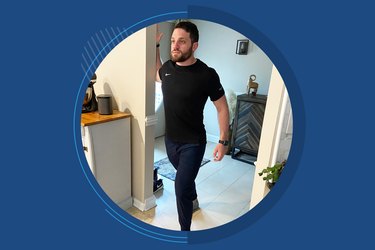
- Standing in a doorway, lift one arm up to a 90-degree angle at shoulder height and position your palm on the door frame.
- Maintain this position and step into the doorway with one leg.
- Lean your chest forward to increase the stretch further.
- Hold for 20 to 30 seconds and repeat two to three times before switching to the opposite side.
Move 6: Chest Expansion/Shoulder Stretch
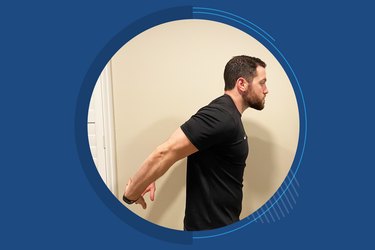
- Interlock your fingers behind your back.
- Lift your knuckles up and away from your lower back without dipping your head and chest too far forward.
- Think about squeezing your shoulder blades together as you reach your hands up to increase the stretch in the front of the chest and shoulders.
- Hold for 20 to 30 seconds and repeat two to three times.
Is this an emergency? If you are experiencing serious medical symptoms, please see the National Library of Medicine’s list of signs you need emergency medical attention or call 911.